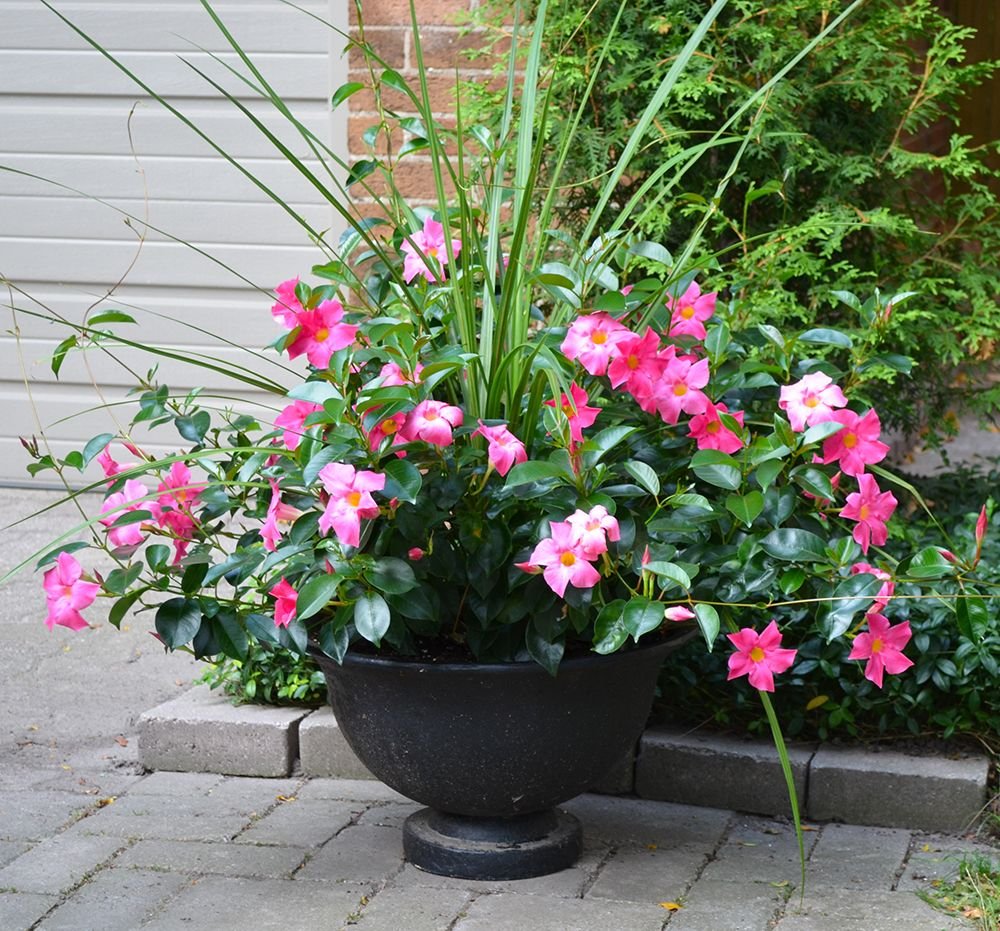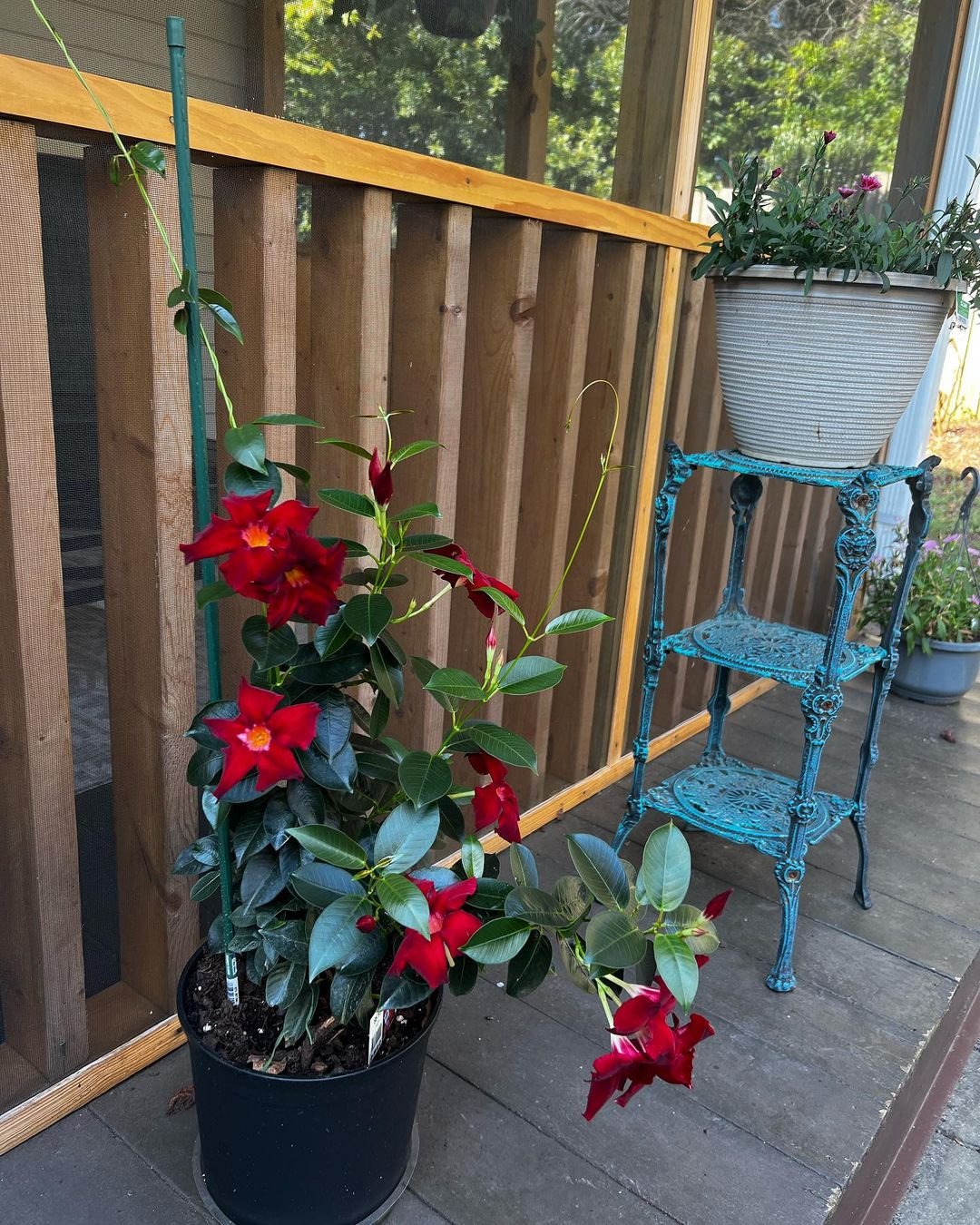Welcome to our in-depth guide on Rio Dipladenia, also known as Rio Mandevilla or Brazilian Jasmine. In this comprehensive article, we will provide you with detailed insights into caring for this stunning perennial vining plant. We will cover everything from its size and growth patterns to its specific requirements for light, temperature, watering, feeding, soil, and maintenance. Additionally, we will address common pests and diseases, its toxicity to humans and pets, and its potential invasiveness.

Here’s a short information chart for Rio Dipladenia:
| Attribute | Information |
|---|---|
| Botanical Name | Mandevilla spp. (hybrid) |
| Plant Type | Evergreen vine |
| Soil Type | Well-drained, fertile soil |
| Color Varieties | Various, including red, pink, white |
| Zones | 9-11 (USDA Hardiness Zones) |
| Exposure | Full sun to partial shade |
| Bloom Time | Spring to fall |
| Height/Spread | 6-10 feet tall / 3-6 feet wide |
Size And Growth
Rio Dipladenia is a remarkable plant that can reach towering heights of up to 15 feet when grown outdoors under ideal conditions. However, when cultivated in containers and pruned properly, it typically maintains a more manageable height of around 2 feet. Its upright growth habit sets it apart from other members of the Apocynaceae family, making it an excellent choice for both indoor and outdoor container gardening.
Flowering And Fragrance
This plant is renowned for its striking appearance, featuring deep green, glossy leaves and producing large, sweetly scented trumpet-shaped blooms. These enchanting flowers grace the plant from spring through autumn, displaying a captivating array of colors, including white, pink, raspberry, and red. Remarkably, Rio Dipladenia continues to bloom abundantly even in hot and humid conditions, making it a favorite among gardeners.
Light And Temperature
Brazilian Jasmine thrives in warm climates and achieves its most prolific flowering when exposed to at least 4 hours of direct sunlight daily. Ideally, it should be planted in full sun, although in exceptionally hot and dry regions, providing morning sun with afternoon shade is preferable. This resilient plant is hardy in USDA zones 9 to 12. In colder regions, it can be cultivated as a houseplant during the winter months and transitioned outdoors in late spring, summer, and early autumn. When grown indoors, it requires ample sunlight, with a south-facing window being the ideal location. West-facing windows can also suffice, but additional artificial light may be necessary.
Watering And Feeding

Rio Dipladenia is a hardy plant capable of withstanding both drought and high humidity. It stores water in underground tubers, which act as a reservoir during dry periods. However, overwatering can lead to tuber rot, so it’s crucial to employ a “soak and dry” watering method. This entails deep watering followed by allowing the soil to dry out before the next watering cycle. For outdoor plants, regular fertilization with an all-purpose fertilizer during spring and summer is recommended. Houseplants benefit from a slow-release 18-6-12 fertilizer application in early spring and again in August. Notably, fertilization should be avoided during the plant’s natural winter rest period, which spans from October to April.
Soil And Transplanting
In USDA zones 9 to 12, Rio Dipladenia can be directly planted into the landscape, provided it receives a minimum of 4 hours of direct sunlight daily and the soil is well-draining. Incorporating ample organic matter into the soil mixture is essential to ensure it remains light and airy. When planting in the landscape, space the plants approximately one foot apart. For container cultivation, choose a container with a diameter of at least 20 inches, ensuring it has sufficient drainage holes. Any well-draining potting mix is suitable for this purpose. The optimal time for planting or transplanting is from mid-spring to late spring, allowing the plant ample time to establish itself before the onset of scorching temperatures.
Grooming And Maintenance

Similar to Knock-Out Roses, Rio Dipladenia continually produces fresh blossoms, eliminating the need for deadheading. Instead, allow spent flowers to fall to the base of the plant, where they will decompose and enrich the soil. It’s important to note that this plant is sensitive to temperatures below 45°F, so protection or indoor shelter is necessary during cold spells. While overwintering indoors, it may shed leaves, but this is not cause for concern. Pruning for tidiness and aesthetics can be performed, and the foliage will rejuvenate in the spring.
How To Propagate Brazilian Jasmine

Propagating Rio Dipladenia is a straightforward process that involves using cuttings placed in potting soil. To maximize root growth, cuttings should be made at a 45-degree angle. Here’s a step-by-step guide:
- Apply rooting hormones to expedite root development.
- Trim all but a few leaves at the tip of the cutting.
- Plant the cuttings in potting soil and water thoroughly.
- Maintain a consistently warm environment with indirect sunlight.
- Keep the soil evenly moist, avoiding excessive saturation.
- New growth should become visible within 2-4 weeks.
Rio Dipladenia Main Pest Or Diseases

Generally, well-maintained Brazilian Jasmine plants exhibit resistance to pests and diseases. However, stressed plants may become susceptible to infestations by pests such as whiteflies, spider mites, mealybugs, and scale insects, particularly when kept indoors during the winter. Adequate sunlight, proper watering, and warmth are essential to prevent these issues. Overwatering can weaken the plant and lead to conditions like root rot, Botrytis blight, crown galls, Fusarium rot, as well as various fungal and bacterial infections. Utilizing the “soak and dry” watering method and ensuring gentle air circulation can mitigate the risk of these problems.
Is The Dipladenia Plant Considered Toxic Or Poisonous?
While Brazilian Jasmine is generally considered non-toxic, it’s worth noting that the milky white sap it contains can irritate the skin. Therefore, wearing gloves when handling and pruning this plant is advisable. Additionally, its unappealing taste deters consumption by animals like rabbits and deer, although the likelihood of ingestion by children, pets, or livestock is minimal. Nonetheless, caution should be exercised by keeping the plant out of their reach.
Is The Dipladenia Plant Considered Invasive?
No, the Dipladenia plant is not considered invasive.
Suggested Rio Dipladenia Uses
The easy-care nature of Rio Dipladenia, coupled with its continuous summer blooms, makes it a magnet for butterflies, bees, and other pollinators. Its natural hardiness renders it an excellent choice for various settings, including landscape plantings, garden beds, planters, and hanging baskets. This vibrant plant thrives alongside other tropical bloomers like allamanda, Ixora, and hibiscus, making it an ideal addition to poolside areas. In colder climates, Rio Dipladenia flourishes as a porch or patio plant during the warmer months and can be maintained as a houseplant in well-lit windows throughout the winter.
In conclusion, Rio Dipladenia, with its breathtaking beauty and versatility, is a remarkable addition to any garden or indoor plant collection. By following the care guidelines outlined in this comprehensive guide, you can ensure that your Brazilian Jasmine thrives and continues to grace your surroundings with its vibrant foliage and exquisite blossoms.
Pingback: How to Grow and Care for the Pickle Plant
Pingback: 17 Best Types of Yucca Plants & How to Care for Them -